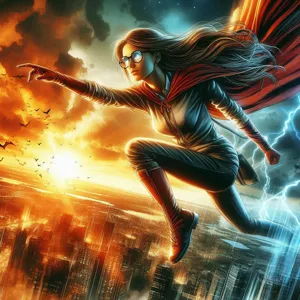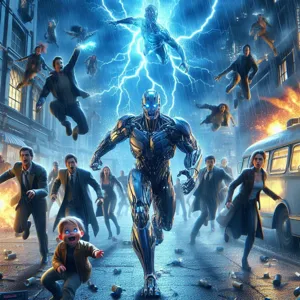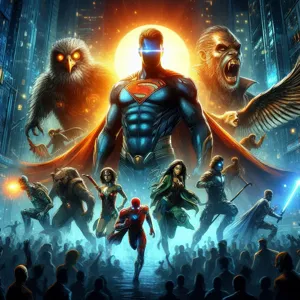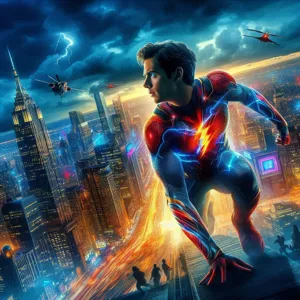As comic book pages burst to life on the silver screen, the journey of superhero movies has transformed not only the landscape of cinema but also the very fabric of popular culture.
From the campy charm of the 1960s “Batman” series to the groundbreaking visual effects of modern blockbusters like the Marvel Cinematic Universe, superhero films have captured the imaginations of audiences across generations. They reflect societal values, fears, and aspirations, mirroring the evolution of our cultural narrative. In this blog post, we will explore the fascinating evolution of superhero movies, tracing their origins, iconic characters, and pivotal moments that have shaped their trajectory. We’ll delve into how these larger-than-life figures resonate with audiences, their role in promoting diversity and inclusivity, and their undeniable impact on the collective consciousness. Join us as we uncover the story of heroes—not just in tights and capes, but as symbols of hope and resilience in an ever-changing world.
1. Introduction: The Rise of Superheroes in Popular Culture

The superhero genre has undergone an extraordinary transformation over the past few decades, evolving from the pages of comic books to become a dominant force in global entertainment. Once relegated to the realm of niche fandoms, superheroes have transcended their origins to capture the hearts and minds of audiences around the world. This remarkable rise can be traced back to a confluence of factors: the advancement of visual effects technology, the growing appeal of cinematic universes, and a cultural landscape hungry for heroes and narratives of resilience.
In the early days, superheroes were confined primarily to comic strips and books, their vibrant capes and extraordinary powers depicted in bold ink and vivid colors. Characters like Superman, Batman, and Wonder Woman emerged as symbols of hope and justice, reflecting the societal values and struggles of their times. However, it wasn’t until the late 20th century that these iconic figures began to leap off the page and onto the silver screen, igniting a renaissance that would reshape the film industry.
The advent of blockbuster superhero films in the early 2000s, starting with hits like “X-Men” and “Spider-Man,” marked a pivotal moment in cinema history. Audiences flocked to theaters, eager to witness their childhood heroes come to life with stunning visual effects and gripping storytelling. The success of these films spawned a new era of superhero storytelling, paving the way for expansive cinematic universes like the Marvel Cinematic Universe and the DC Extended Universe. These franchises not only redefined box office expectations but also expanded the narrative scope, allowing for complex character arcs and intricate interconnections that kept fans eagerly anticipating the next installment.
Beyond their cinematic success, superhero movies have impacted popular culture in profound ways. They address contemporary issues—such as identity, power, and morality—while reflecting the challenges faced by society. As superheroes grapple with their own vulnerabilities and moral dilemmas, audiences find relatable themes that resonate with their everyday lives. This connection has elevated superheroes from mere entertainment to cultural icons, influencing fashion, language, and even political discourse.
In this blog post, we will delve deeper into the evolution of superhero movies, exploring how they have transformed over the years and the cultural significance they hold today. From their humble beginnings in comic books to becoming a multi-billion dollar industry, we will examine the reasons behind their enduring popularity and the impact they continue to have on our collective consciousness. Join us on this journey as we uncover the remarkable story of superheroes and their powerful influence on modern culture.
2. The Origins of Superhero Comics
The origins of superhero comics can be traced back to the early 20th century, a time marked by social upheaval, economic uncertainty, and a burgeoning fascination with the extraordinary. The first true superhero, Superman, emerged from the creative minds of Jerry Siegel and Joe Shuster in 1938, making his debut in Action Comics #1. This iconic character was not just a product of his time; he became a cultural phenomenon that captured the imagination of a generation.
Superman represented the ideal hero—strong, virtuous, and possessing powers that transcended the ordinary human experience. He offered an escape from the harsh realities of the Great Depression, embodying hope and the promise of justice in a world that often felt chaotic and unfair. Following Superman’s success, other superheroes soon sprang into existence, including Batman, Wonder Woman, and Captain America, each reflecting the values and aspirations of their respective eras.
As these superheroes began to populate the pages of comic books, they not only entertained but also provided social commentary on contemporary issues, such as war, civil rights, and the struggle against tyranny. The stories often mirrored the fears and hopes of society, transforming comic books into a powerful medium for discussing complex themes.
By the 1960s and 1970s, the genre underwent further evolution with the introduction of more complex characters and darker narratives, epitomized by Marvel Comics’ Spider-Man and the X-Men. These characters grappled with real-world problems, such as identity, prejudice, and personal responsibility, making them relatable to a wider audience.
The origin of superhero comics laid the groundwork for the rich tapestry of stories that would eventually leap from the page to the screen. It set in motion a cultural shift that recognized the superhero narrative as a means of exploration and expression, paving the way for the blockbuster films that dominate the box office today. The legacy of these early comics continues to resonate, influencing not only entertainment but also shaping societal perceptions of heroism and moral integrity in the modern world.
3. The Transition from Comics to Film: Early Adaptations
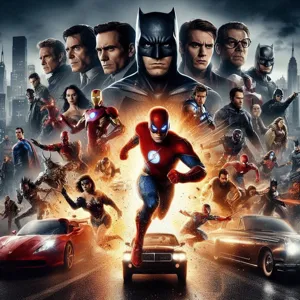
The journey from comic book pages to the silver screen has been a fascinating evolution, marked by both triumphs and missteps. Early adaptations of superhero stories in film were often hampered by the limitations of technology and the nascent understanding of the genre’s potential. The first notable foray into this realm came in the 1940s with the “Batman” serials, where the caped crusader swung into action in a black-and-white format, showcasing the iconic character while grappling with the constraints of low budgets and special effects.
As the decades progressed, the 1970s heralded a new era with the release of “Superman: The Movie” in 1978. This film was revolutionary, not only for its groundbreaking visual effects but also for its earnest portrayal of the superhero mythos. Christopher Reeve’s performance as the Man of Steel elevated the genre, setting a benchmark for future adaptations. Audiences were captivated by the film’s blend of adventure, romance, and humor, which helped to crystallize the superhero’s role in popular culture.
However, not all adaptations were met with acclaim. The 1980s saw a flurry of less successful attempts, including the notorious “Superman IV: The Quest for Peace,” which suffered from a convoluted plot and lackluster production values. This period underscored the challenges of translating the richness of comic narratives into film, often resulting in films that missed the essence of the source material.
The late ’90s and early 2000s marked a resurgence in superhero films, culminating in the release of “X-Men” in 2000 and “Spider-Man” in 2002. These films reinvigorated the genre by introducing complex characters and moral dilemmas, resonating with audiences on a deeper level. The successful adaptation of these beloved franchises highlighted the potential for superhero films to not only entertain but also address themes of identity, power, and responsibility.
As the transition from comics to film evolved, so did the cultural impact of these adaptations. They became more than just entertainment; they served as a reflection of societal values, fears, and aspirations. The superhero genre began to explore relevant issues such as diversity, mental health, and the implications of technology, allowing audiences to connect with these characters in ways that transcended their fictional origins.
In conclusion, the transition from comic books to film has been a transformative journey that has shaped the superhero genre into a cultural phenomenon. Each adaptation, whether successful or not, has contributed to the rich tapestry of storytelling that continues to captivate audiences around the world, paving the way for a new generation of superhero narratives that speak to the complexities of modern life.
4. The Birth of the Modern Superhero Movie: The 2000s Era
The dawn of the 2000s marked a pivotal moment in the evolution of superhero movies, heralding the birth of the modern superhero film as we know it today. With the release of *X-Men* in 2000, the genre began to shed its campy reputation, favoring a more serious and nuanced approach to storytelling. Directed by Bryan Singer, *X-Men* not only introduced audiences to a diverse ensemble of characters grappling with societal issues like discrimination and acceptance but also set a new standard for character development, blending action with real-world themes.
Just a few years later, in 2002, Sam Raimi unleashed *Spider-Man*, a film that would redefine box office expectations and superhero storytelling. With Tobey Maguire embodying the iconic web-slinger, the film captured the essence of Peter Parker’s dual life, resonating with audiences through its relatable themes of responsibility and sacrifice. The heart-stopping action sequences, combined with a poignant narrative, painted a vivid picture of what superhero films could achieve—an exhilarating blend of spectacle and depth.
As the decade progressed, the rise of the Marvel Cinematic Universe began with *Iron Man* in 2008, further solidifying the superhero genre’s foothold in mainstream cinema. Robert Downey Jr.’s charismatic performance as Tony Stark not only revitalized the character but also established a new era of interconnected storytelling, with each film contributing to an overarching narrative. This ambitious approach captivated audiences and set the stage for an unprecedented franchise model that would dominate the box office for years to come.
The 2000s era was not merely about the films themselves; it reflected a cultural shift as well. Superheroes became icons of hope and resilience during tumultuous times, serving as both escapism and mirrors to societal struggles. The genre began to explore complex moral dilemmas, pushing the boundaries of traditional storytelling and inviting deeper discussions about heroism, justice, and humanity.
As we reflect on this transformative decade, it’s clear that the modern superhero movie emerged not just as a cinematic phenomenon but as a cultural touchstone, influencing everything from fashion and advertising to the very fabric of pop culture itself. The 2000s laid the groundwork for the superhero genre’s evolution, making it a staple of Hollywood and a beloved part of global culture—a legacy that continues to thrive today.
5. Key Milestones in Superhero Cinema
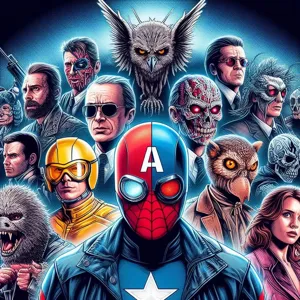
The journey of superhero cinema is marked by several key milestones that have not only shaped the genre but also reflected and influenced cultural sentiments over the decades.
One of the earliest milestones can be traced back to 1978 with the release of “Superman: The Movie.” Starring Christopher Reeve, this film was groundbreaking in its portrayal of a superhero on the big screen. It elevated the genre from the realm of campy television shows and comic book adaptations to a serious cinematic experience, capturing the imagination of audiences worldwide. Its success set a precedent for future adaptations and demonstrated that superhero films could achieve critical acclaim and box office success.
Fast forward to 1989, and Tim Burton’s “Batman” redefined the superhero film once again. With its darker tone and stylized visuals, it introduced a new era of comic book adaptations that appealed not just to children but also to adults. Michael Keaton’s portrayal of the brooding caped crusader, paired with Danny Elfman’s haunting score, showcased the potential for complex characters and narratives within the genre.
The turn of the millennium brought about another significant shift with the release of “X-Men” in 2000. This film effectively spotlighted themes of diversity, acceptance, and the struggle against prejudice—issues that resonated deeply with contemporary audiences. It also marked the beginning of the modern superhero blockbuster era, leading to a slew of successful franchises that followed.
In 2008, Marvel’s “Iron Man” ignited the Marvel Cinematic Universe (MCU), a sprawling interconnected series of films that revolutionized how stories could be told across multiple platforms. This innovative approach not only captivated audiences but also set the stage for crossover films like “The Avengers” in 2012, which became a cultural phenomenon in its own right. The MCU’s emphasis on character development and humor, coupled with its ability to tackle serious societal issues, helped solidify superhero films as a dominant force in Hollywood.
As we look toward the future, the continuing evolution of superhero cinema raises important questions about representation and narrative depth. Films like “Black Panther” and “Wonder Woman” have made strides in showcasing diverse perspectives and have sparked conversations about inclusivity in the genre. Meanwhile, television series like “WandaVision” and “The Falcon and the Winter Soldier” demonstrate that superhero narratives can thrive on different platforms, further enriching the cultural landscape.
Each of these milestones not only showcases the evolution of superhero cinema but also reflects the changing values and concerns of society. As we continue to embrace the world of superheroes, it’s clear that their impact goes far beyond mere entertainment; they serve as a mirror to our collective psyche, capturing the hopes, fears, and aspirations of generations.
6. The Marvel Cinematic Universe: Redefining the Genre
The Marvel Cinematic Universe (MCU) has undeniably redefined the superhero genre, transforming it from niche entertainment into a cultural phenomenon that captivates audiences worldwide. Launched with the release of “Iron Man” in 2008, the MCU has meticulously crafted a sprawling narrative universe that intertwines characters, storylines, and themes across multiple films and television series. This ambitious approach not only captivated longtime comic book enthusiasts but also drew in a new generation of viewers who might have otherwise overlooked the genre.
One of the key elements of the MCU’s success is its ability to blend action, humor, and emotional depth, creating stories that resonate on multiple levels. Characters like Tony Stark, Steve Rogers, and Natasha Romanoff have become household names, each with their unique arcs that explore themes of heroism, sacrifice, and the complexities of morality. The franchise’s commitment to character development allows audiences to form deep emotional connections with its heroes and villains alike, making their triumphs and tragedies all the more impactful.
Moreover, the MCU has also been a trailblazer in fostering a sense of community among fans. The anticipation surrounding each new release, complete with post-credits scenes and interconnected storylines, has created a culture of speculation and discussion that thrives online and offline. Fan theories, merchandise, and cosplay have all contributed to a vibrant ecosystem where fans feel personally invested in the narrative, further solidifying the MCU’s place in contemporary popular culture.
However, the impact of the MCU extends beyond just entertainment; it has also sparked important conversations around representation and diversity in superhero storytelling. With films like “Black Panther” and “Captain Marvel,” the MCU has taken significant strides in showcasing a broader spectrum of characters and stories, challenging long-standing norms within the genre. This commitment to inclusivity not only enriches the narrative landscape but also allows underrepresented audiences to see themselves reflected in the heroes they admire.
As we look to the future, the MCU continues to evolve, incorporating new characters and exploring fresh narratives, all while maintaining the core themes that have made it so successful. In doing so, it not only redefines the superhero genre but also leaves an indelible mark on global culture, inspiring filmmakers and audiences alike to embrace the extraordinary possibilities of storytelling.
7. The Dark Knight Trilogy: A Shift in Tone and Style
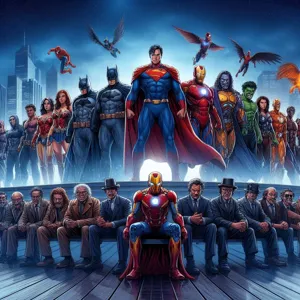
The release of Christopher Nolan’s *The Dark Knight Trilogy* marked a pivotal moment in the landscape of superhero filmmaking, redefining not only the genre but also its cultural significance. Starting with *Batman Begins* in 2005 and culminating in the iconic *The Dark Knight* (2008) and *The Dark Knight Rises* (2012), Nolan’s trilogy introduced a darker, more complex narrative that resonated with audiences in a way that previous adaptations had not.
Gone were the campy tones and exaggerated villains that characterized earlier superhero films; instead, Nolan crafted a grounded, gritty portrayal of Gotham City and its inhabitants. His vision explored profound themes such as morality, chaos, and the psychological burdens of heroism. Heath Ledger’s haunting performance as the Joker in *The Dark Knight* elevated the film to new heights, presenting a villain whose chaotic philosophy challenged not just Batman but the very fabric of society. This portrayal sparked discussions about the nature of evil and the consequences of vigilantism, pushing the boundaries of what superhero narratives could convey.
The trilogy’s visual style also played a crucial role in its impact. Nolan’s use of practical effects, combined with IMAX technology, created a cinematic experience that was immersive and visually stunning. The action sequences felt visceral and real, making the stakes feel higher than ever before. This shift in style set a new benchmark for future superhero films, influencing everything from cinematography to score, with Hans Zimmer’s iconic soundtrack becoming synonymous with the franchise.
Culturally, *The Dark Knight Trilogy* did more than just entertain; it sparked a renaissance in superhero storytelling. It encouraged filmmakers to take risks and delve into more mature themes, paving the way for subsequent franchises to explore darker narratives. The trilogy prompted audiences to reconsider what it meant to be a hero and the complexities that come with such a title. As a result, it solidified Batman’s place as one of the most compelling figures in popular culture, inspiring a generation of filmmakers and fans alike.
Ultimately, *The Dark Knight Trilogy* stands as a monumental achievement in cinema, not only for its artistic innovations but also for its lasting impact on the superhero genre and its ability to provoke thought and discussion about the nature of heroism in an increasingly complicated world.
8. Representation and Diversity in Superhero Films
The landscape of superhero films has undergone a remarkable transformation over the past few decades, with representation and diversity emerging as critical themes that resonate deeply with audiences. Historically, the genre was dominated by a narrow spectrum of characters, predominantly male and often white, reflecting societal norms and biases of the time. However, as cultural conversations about equity and representation have gained momentum, filmmakers have begun to embrace a more inclusive approach, giving rise to a broader array of heroes and stories.
Today, we see a vibrant tapestry of characters that reflect a wide range of backgrounds, abilities, and experiences. Films like “Black Panther” and “Wonder Woman” have not only shattered box office records but have also redefined the superhero canon by centering narratives that celebrate cultural heritage and gender empowerment. These films serve as powerful reminders that heroism is not confined to a single archetype; rather, it is a universal quality that can be found in every community.
Moreover, the introduction of characters like Ms. Marvel and Shang-Chi has opened the door for underrepresented voices within the superhero universe, allowing audiences to connect with heroes who mirror their own identities and struggles. This surge in diversity has sparked important dialogues about race, gender, and the power dynamics within both the comic book and film industries. It encourages aspiring creators from all backgrounds to share their stories and perspectives, ultimately enriching the genre as a whole.
As superhero films continue to evolve, they are not just entertaining spectacles but also cultural phenomena that reflect and influence societal values. By prioritizing representation and diversity, filmmakers are not only broadening the appeal of these stories but are also paving the way for a future where everyone can see themselves as heroes in their own right. In this ever-expanding universe, the message is clear: heroism knows no boundaries, and every voice deserves to be heard.
9. The Impact of Technology on Superhero Storytelling
The evolution of technology has dramatically reshaped the landscape of superhero storytelling, enhancing both the narrative depth and visual spectacle of these beloved films. From the early days of simplistic animations and practical effects to the breathtaking CGI and immersive virtual reality experiences of today, advancements in technology have opened up new avenues for creativity and engagement.
In the late 20th century, superhero movies began to embrace special effects that could bring comic book heroes to life in ways previously unimaginable. Films like “Superman” (1978) and the “Batman” series of the 1980s and 1990s introduced audiences to a blend of physical stunts and rudimentary digital effects, setting the stage for more ambitious projects. However, it wasn’t until the turn of the millennium, with the release of films like “Spider-Man” (2002) and “X-Men” (2000), that technology truly began to transform the genre. Enhanced CGI allowed for more dynamic action sequences and the realistic portrayal of superhuman abilities, captivating audiences and pushing the boundaries of what was possible on screen.
Today, the use of cutting-edge technology extends beyond visual effects. advanced motion capture techniques have revolutionized character portrayal, allowing actors to bring complex, digitally-rendered characters to life with greater nuance and emotion. Films like “Avatar” (2009) and Marvel’s “Thanos” in “Avengers: Infinity War” (2018) showcase how technology can create not only visually stunning but also deeply relatable characters. As a result, audiences are not just passive viewers; they are emotionally invested in the narratives, fostering a deeper connection with the stories being told.
Moreover, technology has also transformed the way stories are delivered. Streaming platforms such as Disney+ and Netflix have redefined how superhero narratives unfold, enabling serialized storytelling that allows for character development over multiple episodes. This shift not only keeps audiences engaged for longer periods but also provides creators with the freedom to explore complex themes and character arcs in a way that traditional cinema often cannot. Series like “WandaVision” and “The Falcon and the Winter Soldier” illustrate how episodic storytelling can delve into the psychological and societal implications of being a superhero, offering a fresh perspective on familiar characters.
In conclusion, the impact of technology on superhero storytelling is profound, expanding the possibilities for narrative exploration and audience engagement. As we continue to witness new technological advancements, the superhero genre will undoubtedly evolve further, reflecting not only the capabilities of filmmakers but also the changing cultural landscape in which these stories resonate. With each leap forward, we can expect even more innovative and impactful storytelling that captivates both the heart and mind of audiences around the world.
10. Cultural Reflections: How Superhero Movies Address Social Issues
Superhero movies have always been more than mere escapism; they serve as vibrant reflections of the society from which they emerge. As the genre has evolved, so too has its ability to address pressing social issues, making it a powerful medium for cultural commentary. From the early days of Superman, who represented hope and resilience during the Great Depression, to the modern complexities explored in films like “Black Panther” and “Wonder Woman,” these stories have continually mirrored the challenges and aspirations of their times.
Take “Black Panther,” for example. Released in 2018, it not only broke box office records but also sparked vital conversations about race, identity, and representation. Set in the fictional African nation of Wakanda, the film juxtaposes the struggles of marginalized communities with the concept of empowerment through technology and heritage. It challenges viewers to reconsider stereotypes and highlights the importance of diverse voices in media. The film’s impact was felt across various platforms, igniting discussions about the significance of representation in Hollywood and inspiring a new generation of filmmakers.
Similarly, “Wonder Woman” brought to the forefront issues of feminism and gender equality. By presenting a female superhero who embodies strength, compassion, and agency, the film inspired audiences to rethink traditional gender roles and advocate for women’s rights. It prompts not only admiration for the character but also reflection on the real-world implications of gender dynamics in society.
In addition to race and gender, superhero films have also tackled pressing issues such as mental health, environmental concerns, and the consequences of power. Movies like “Logan” delve into themes of aging, loss, and trauma, capturing the vulnerability and humanity of their heroes in ways that resonate deeply with audiences. This blend of action and heartfelt storytelling encourages viewers to engage with and reflect upon their own lives and societal challenges.
As superhero movies continue to dominate the box office, their ability to address and reflect social issues will only grow in importance. They serve as a lens through which we can explore complex themes, challenge prevailing narratives, and inspire change. Ultimately, it is this cultural relevance that ensures the superhero genre remains not just a source of entertainment, but a significant force for social dialogue and reflection in contemporary society.
11. The Global Appeal of Superhero Films
Superhero films have transcended borders, weaving a rich tapestry of global appeal that resonates with audiences from diverse cultures. This cinematic genre, initially rooted in American comic book traditions, has evolved into a universal phenomenon that captivates millions worldwide. The allure of superhero narratives lies not just in their thrilling action sequences or spectacular special effects, but in their ability to tell timeless stories of heroism, identity, and the battle between good and evil.
One of the key factors contributing to the global appeal of superhero films is their relatability. Characters like Spider-Man, Wonder Woman, and Black Panther embody struggles that resonate with audiences regardless of geography—be it the quest for justice, the burden of responsibility, or the importance of community. These themes bridge cultural divides, allowing viewers to see reflections of their own lives and aspirations in the journeys of these iconic heroes.
Moreover, the globalization of the film industry has introduced diverse perspectives into the superhero genre. Films like “Black Panther” not only celebrate Black culture but also highlight the significance of representation in media. Similarly, “Shang-Chi and the Legend of the Ten Rings” showcases Asian culture and mythology, demonstrating that superhero narratives can be enriched by drawing from a variety of cultural backgrounds. This infusion of diversity not only broadens the appeal of these films but also fosters a sense of inclusivity, inviting audiences from all walks of life to partake in the superhero experience.
The rise of streaming platforms has further amplified the global reach of superhero films. With audiences able to access content from all over the world at their fingertips, superhero narratives can now find their way into homes regardless of location. This access has also encouraged the production of international superhero stories, expanding the genre to include heroes and stories that resonate with different cultures, such as India’s “Ra.One” or South Korea’s “The Divine Fury.”
As superhero films continue to dominate the box office, their cultural impact is undeniable. They not only entertain but also inspire discussions on moral dilemmas, social justice, and the human condition. Through their universal themes and rich storytelling, these films have become a cultural touchstone, fostering a shared language that connects audiences around the globe. In a world that often feels fragmented, superhero films serve as a powerful reminder of our shared struggles and dreams, uniting us through the timeless appeal of heroism.
12. From Page to Screen: Changes in Character Portrayals
The transition of superhero characters from comic book pages to the silver screen has not only revolutionized the film industry but also significantly altered the way these beloved figures are portrayed. In the early days of superhero cinema, characters often adhered closely to their comic book origins, embodying the straightforward morality and exaggerated traits that defined the golden age of comics. Heroes like Superman and Batman were presented as larger-than-life figures, representing clear ideals of justice and heroism.
However, as societal norms and expectations evolved, so too did the portrayal of these characters. The late 20th and early 21st centuries ushered in a new era of complexity and depth, reflecting a more nuanced understanding of humanity. Characters like Spider-Man and Iron Man began to grapple with personal dilemmas, moral ambiguity, and the weight of their responsibilities. This shift not only made them more relatable but also allowed filmmakers to explore themes of identity, sacrifice, and the gray areas of good and evil.
For instance, while traditional comic book narratives often presented heroes with unshakeable confidence and unwavering principles, contemporary adaptations have introduced vulnerabilities and internal conflicts. The depiction of characters like Wolverine showcases a tortured soul wrestling with his past, while the evolution of Harley Quinn from a villainous sidekick to a multi-dimensional anti-heroine highlights the importance of character growth and empowerment.
Moreover, the diversity of portrayals has expanded significantly, allowing for a broader representation of gender, race, and sexuality. Films like “Black Panther” and “Wonder Woman” not only celebrate the strength and heroism of their protagonists but also address cultural narratives and social justice issues. These changes in character portrayals resonate with audiences on a personal level, inviting them to see themselves in the heroes they once idolized.
As we continue to witness the evolution of superhero movies, it’s clear that these characters are no longer confined to their comic book roots. They have become cultural icons that reflect the complexities of modern life, challenging viewers to rethink what it means to be a hero in an ever-changing world. The interplay between page and screen is a dynamic one, and it will be fascinating to see how these portrayals continue to develop in the years to come.
13. The Future of Superhero Movies: Trends and Predictions
As we stand on the precipice of a new era in superhero cinema, the future promises to be as exhilarating as the stories we’ve come to love. With the genre’s evolution over the past few decades, we can anticipate several key trends that will shape its trajectory in the coming years.
First and foremost, the advent of streaming platforms has significantly altered the landscape of film distribution and consumption. As more viewers migrate to platforms like Disney+, Netflix, and HBO Max, we can expect superhero narratives to expand beyond the traditional two-hour format. Limited series and episodic storytelling allow for deeper character development and intricate plotlines, giving creators the flexibility to explore the complex moral dilemmas that define these heroes. Imagine a world where a character’s arc spans an entire season, allowing for nuanced storytelling that a feature film simply cannot achieve.
Moreover, the rise of diverse storytelling is set to flourish in this new era. Audiences are increasingly demanding representation on screen, and studios are beginning to respond. This shift is not just about inclusivity; it’s about enriching the superhero universe with unique perspectives and narratives. We can look forward to a broader array of superheroes from different cultures, genders, and backgrounds, each bringing their own stories and struggles to the forefront. This evolution will not only resonate with a wider audience but will also reflect the diversity of our society.
Another trend to watch is the blending of genres. Superhero narratives have historically operated within a specific framework, but recent films have begun to experiment with elements from other genres—horror, comedy, and even romance. As filmmakers continue to push boundaries, we may see superhero stories that incorporate these diverse elements in innovative ways, making them more relatable and engaging for a wider audience.
Furthermore, the impact of technology on storytelling cannot be understated. With advancements in visual effects, virtual reality, and augmented reality, the potential for immersive experiences is limitless. Imagine attending a superhero film that allows you to step directly into the narrative through VR technology or participating in interactive screenings where your choices affect the storyline. Such innovations could transform the way we engage with these stories, making the experience more personal and dynamic.
Lastly, as superhero movies increasingly reflect societal issues—from mental health to environmental concerns—we can expect a greater emphasis on storytelling that resonates with real-world challenges. This trend not only elevates the genre but also positions it as a powerful medium for social commentary, encouraging audiences to reflect on their own lives and the world around them.
In conclusion, the future of superhero movies is bright and brimming with possibilities. As we continue to explore new narratives, embrace diversity, and leverage technology, the impact of these films will undoubtedly evolve, ensuring that they remain relevant and compelling for generations to come. With each new release, we inch closer to uncovering the full potential of superhero storytelling, making it an exciting time for fans and filmmakers alike.
14. Conclusion: The Lasting Legacy of Superheroes in Film and Society
As we reflect on the evolution of superhero movies and their profound cultural impact, it becomes clear that these larger-than-life characters have transcended mere entertainment to become cornerstones of modern society. From the humble beginnings of comic book origins to the technologically advanced blockbusters dominating the box office today, superheroes have not only captured our imaginations but also mirrored our societal values, struggles, and aspirations.
The lasting legacy of superheroes in film is evident in their ability to inspire resilience, promote justice, and encourage the triumph of good over evil. Icons like Superman and Wonder Woman have become symbols of hope and empowerment, resonating with audiences across generations. The diversity and complexity of characters in recent films reflect an increasingly inclusive narrative that speaks to a broader spectrum of experiences and identities, making superhero stories more relevant than ever.
Moreover, the cultural phenomenon surrounding superhero films has sparked vital conversations about morality, responsibility, and the human condition. These narratives often challenge viewers to consider their own roles in society, prompting discussions about heroism in everyday life and the impact of individual actions on the community at large. As superheroes continue to evolve and adapt to contemporary issues, they serve as both a reflection of our current realities and a source of inspiration for future generations.
In conclusion, superhero movies are more than just thrilling spectacles; they embody the hopes, fears, and dreams of society. Their legacy extends beyond the screen, shaping our cultural landscape and inspiring us to strive for a better world. As we look ahead, it is certain that superheroes will remain a powerful force in film and society, reminding us that within each of us lies the potential to be a hero in our own right.
15. Further Reading and Resources on Superhero Evolution
As we conclude our exploration of the evolution of superhero movies and their profound cultural impact, we recognize that this dynamic genre continues to captivate audiences around the globe. For those who wish to delve deeper into this fascinating subject, we’ve compiled a selection of further reading and resources that will enrich your understanding and appreciation of superhero narratives in film and beyond.
**Books:**
1. **”Superhero Movies: A History” by Ian Gordon** – This comprehensive volume traces the origins of superhero films, analyzing key milestones in the genre’s development and providing insights into the cultural contexts that shaped them.
2. **”The Superhero Book: The Ultimate Encyclopedia of Comic-Book Icons and Hollywood Heroes” by Gina Misiroglu** – An extensive reference that covers a wide range of superhero characters and their cinematic adaptations, this book offers both historical perspectives and contemporary analyses.
3. **”Marvel Comics: The Untold Story” by Sean Howe** – An in-depth look at the Marvel Universe, this book chronicles the rise of the company and its influence on the superhero film industry, highlighting how comic book storytelling has evolved.
**Documentaries:**
1. **”The Story of DC Comics”** – This documentary offers a behind-the-scenes look at one of the most influential comic book publishers in history, exploring how its characters have transitioned from the pages of comics to blockbuster films.
2. **”Superheroes: A Never-Ending Battle”** – A three-part PBS series that examines the history of superheroes, this documentary features interviews with key creators and historians, providing rich insights into the genre’s development.
**Online Resources:**
1. **Comic Book Resources (CBR)** – A great online hub for news, reviews, and analysis about comics and superhero films. Their articles often delve into the cultural significance and evolving narratives within the genre.
2. **The Comics Journal** – For those interested in a more academic approach, this publication offers critical essays and scholarly articles on comic book art and storytelling, including discussions of superhero films and their impact.
**Podcasts:**
1. **”Superhero Ethics”** – This podcast explores the moral and philosophical questions raised by superhero stories, encouraging listeners to think critically about the implications these narratives have on society.
2. **”Fat Man on Batman”** – Hosted by filmmaker Kevin Smith, this podcast dives into the world of comic book movies and their cultural significance, featuring interviews with industry insiders and discussions on current trends.
By engaging with these resources, you can further appreciate the intricate web of influences that have shaped superhero cinema. Whether you’re a lifelong fan or a newcomer to the genre, these materials will enrich your understanding of how these iconic heroes have evolved over time and their lasting impact on our culture. Happy reading!
As we wrap up our exploration of the evolution of superhero movies and their profound cultural impact, it’s clear that these films have transcended mere entertainment to become significant cultural touchstones. From their humble comic book origins to the spectacle of modern-day blockbusters, superhero narratives have evolved to reflect societal values, challenge norms, and inspire audiences across generations. They resonate with our collective hopes and fears, often serving as a mirror to the world we live in. As we look to the future, it will be fascinating to see how these stories continue to adapt and evolve, shaping and reflecting our culture in new ways. Thank you for joining us on this journey through the vibrant world of superhero cinema; we encourage you to keep the conversation alive and share your thoughts on the heroes that inspire you!

